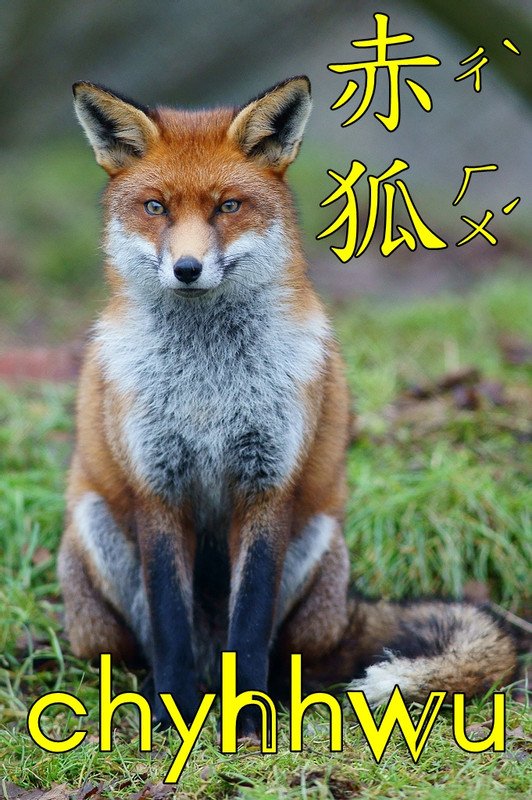
Red Fox
The scientific name of the red fox, Vulpes vulpes (“fox fox” in Latin), is a reminder that this is the most common of all foxes. Its omnivorous appetite and ability to easily adapt to new environments has made it a pest throughout the northern hemisphere. In Australia, foxes have even learned to climb eucalyptus trees to hunt and kill tree-dwelling animals: https://www.newscientist.com/article/2120944-foxes-seen-climbing-trees-at-night-to-track-down-and-eat-koalas/

[Red Fox 赤狐 chyhhwu, GR Tonal Spelling (Gwoyeu), Fox_study_6, CC--BY Peter Trimming]
赤狐
狐狸分布於全球各地,是食肉目中分布最廣的動物,而種類最多的莫過於北半球的赤狐,學名 Vulpes vulpes 是拉丁文『狐狐』(= 一般人心目中最具代表性的狐狸)的意思。狐狸很很會適應新的環境,在澳洲科學家赫然發現吃狐狸學會爬樹獵捕無尾熊(尤加利樹比較容易攀爬)。
Bat-Eared Fox
The ears of the bat-eared fox (the scientific name Otocyon megalotis means “big-eared ear-dog” in Greek) help it cool off and locate prey (mostly termites, but also other insects) in its home, mostly in East Africa.

[00-大耳狐 daheelhwu, GR Tonal Spelling (Gwoyeu), Bat-eared fox, Otocyon megalotis, at Kgalagadi Transfrontier Park, CC--By Derek Keats]
大耳狐
大耳狐,是生活在非洲的犬科動物,因其耳大而得名,學名 Otocyon megalotis 是希臘文『耳 Oto +犬 cyon+大 megalo + 耳 otis = 意思是『有大耳朵的狗類動物』。一般家犬不容易冒汗所以用舌頭排熱,而『大耳狐』靠耳朵來散熱。另外一點比較值得注意是大耳狐以白蟻為主食,同時也是水分的主要來源。
Grey Fox
The scientific name of the grey fox, Urocyon cinereoargenteus, is made of Greek and Latin roots:Greek Uro “tail” and cyon “dog” + Latin cinereo “ashes, cinders” and argenteus “silver” = silver-grey tail-dog. This smallish animal, found from southern North America all the way to northern South America, is able to climb trees, thus enabling it to stay safe from predators such as wolves and coyotes.

[00-grey fox, 灰狐 hueihwu, GR Tonal Spelling (Gwoyeu) Urocyon cinereoargenteus, CC--BY Brian Gratwicke]
灰狐
灰狐,學名 Urocyon cinereoargenteus 是希臘文『尾Uro + 犬cyon』和拉丁文『 灰 cinereo + 銀 argenteus』= 『有灰色尾巴的狗類動物』,主要分布於北美洲和南美洲北部。灰狐棲息於森林地帶,遇到天敵(家犬和郊狼)他會很快地爬到樹上。
Arctic Fox
Because its beautiful fur is much in demand, the arctic fox has almost gone extinct in northern Scandinavia. However, it is still secure in more remote areas of the arctic.

[Arctic Fox, 北極狐 beeijyihwu, GR Tonal Spelling (Gwoyeu) Fjellrev_-Arctic_fox(24490250823), CC--BY-SA Erik F. Brandsborg]
北極狐
北極狐冬天的毛色很白毛皮算高檔貨,所以成為獵捕的目標。以全世界的北極狐來說保護狀况算是低關注度物種,但北歐一帶快絕種。
Romanization Notes
the names of the foxes in this article are annotated in two different ways:
(1) using Bopomofo (ruby on the side of each Chinese character), a system created in China in 1918
(2) using GR Tonal Spelling (AKA Gwoyeu Romatzyh), a romanized system created in China in 1928 as an adjunct to Bopomofo. Its creators, headed by 趙元任 (China's greatest modern linguist) were a subgroup of the same committee that created Bopomofo.
In both cases, they were inspired by 反切 fǎnqiè / faanchieh, a syllabic system (one rhyme, one spelling) that works differently from Hanyu Pinyin, a purely alphabetic (one phoneme, one spelling) system:
https://en.wikipedia.org/wiki/Fanqie
Birds
"Birdy" (easily guessable) Names Formed with 鳥 neau / niǎo
https://steemit.com/nature/@wentong-syhhae/birdy-easily-guessable-names-formed-with-neau-ni-o
Other Critters
Six Legs Bad, Four Legs Good: More Characters with the 虫 radical (shiyih ching’ua lay har.ma rongyuan bianfwu tsyhwey 蜥蜴 青蛙 癩蛤蟆 蠑螈 蝙蝠 刺蝟)
https://steemit.com/animals/@wentong-syhhae/six-legs-bad-four-legs-good-more-characters-with-the-radical-shiyih-ching-ua-lay-har-ma-rongyuan-bianfwu-tsyhwey
Who I am:
https://steemit.com/introduceyourself/@wentong-syhhae/enthusiastic-intp-polyglot
The bat-eared fox photo at the very top (group of 4) is Creative Commons:
Otocyon_megalotis_-_Etosha_2014, CC--BY-SA Yathin S Krishnappa
The other three photos (red fox, grey fox and arctic fox) are Public Domain (PD) images from Pixabay.